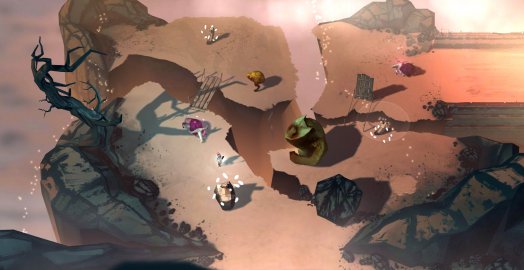Review for Peregrin

Adventures have been around long enough to coincide with the development of virtually every type of gaming experience that exists today, and increasingly they have begun to incorporate other gameplay elements themselves. While such experiments vary drastically in quality, Domino Digital's Peregrin demonstrates that such genre-bending can be very effective, as it manages to seamlessly mix an adventure game interface with unique environmental puzzle solving, some short stealth segments and a turn-based RPG-styled combat system. The presentation is highlighted by gorgeous artwork, solid voice acting, and immersive world building, all put together with an exemplary professional polish and craft. It isn't perfect—notably, there is a sense of separation between gameplay and story, and the short runtime allows neither to develop to a desirable depth. With a modicum of expansion, Peregrin could have been a masterpiece; what we are instead left with is something more like a hearty and savory appetizer trying to pass itself off as an entire meal.
Peregrin's postapocalyptic setting is one of its strongest components, as behind the events of this game is an evocative and fascinating fictional world. You play as Abi, wandering through a dark and ruinous region known as “the divide.” Civilization is now in chaos following several millennia of peace, a state of instability set into motion when humanity discovered an object known as the Oblion, described as “the ancient remains of the gods' ancestors.” An attempt to use the Oblion to eradicate death precipitated a war of the gods, in which mankind's sole ally among the deities, List, was ultimately vanquished by his vengeful older brothers, Or and Ot. In addition to hacking List's body into pieces and casting it upon the world in a devastating bombardment, Or and Ot took away mankind's ability to learn and understand itself and its surroundings. Since the fallout, it has been the tradition of Abi's scavenger tribe that the strongest attempt a pilgrimage through the divide, seeking atonement.
As the latest of her tribe to undertake this pilgrimage, Abi has mastered the art of the Eloheem, which serves as Peregrin's core gameplay mechanic. The Eloheem allows Abi to telepathically control nearby creatures, utilizing their abilities to solve an assortment of puzzles. There are three creatures you can possess. The cliff goat can ram various objects that will help you travel across otherwise impassable gaps. The nab toad can snatch faraway items with its long tongue, moving them to new locations; it can also push distant buttons. Finally, the grub troll can lift and move heavy things such as rocks and large barrels. Since these creatures are fortuitously encountered wherever they’re needed, their presence often functions as a helpful hint to the puzzles that must be solved nearby.
The ultimate goal in overcoming these environmental obstacles is to create a path for Abi to traverse the ruinous terrain. In order to make use of the Eloheem, you must activate hotspots called totems. When a totem is activated, it creates a distinct area in which creatures can be controlled. The puzzles start off fairly straightforward—requiring you to, say, use the cliff goat to bash a bridge down so that you can cross it, or the grub troll to move a boulder out of the way so you can advance through a passageway. Sometimes you might need to use the nab toad to snatch and relocate gems that the other creatures are attracted to, thus luring them into an area where they can be possessed. Appropriately, these puzzles grow in complexity as the game progresses, and while they are never overwhelmingly challenging, they are sometimes intricate enough to inspire a good head-scratching until you are able to intuit your way to a solution.
Occasionally you’ll need to dash from hiding spot to hiding spot to escape detection from mechanical defense mechanisms, but the main other source of gameplay is found in an RPG-influenced combat system. While the nab toads, cliff goats, and grub trolls are all harmless, there are a number of malevolent creatures scattered throughout the divide that must be defeated. The combat system is mostly a standard turn-based one, but it features a uniquely charming twist that makes use of the Eloheem. Enemies linger around in easily identified battle zones; once you step into these areas, you will automatically engage in combat and must see the fight through to its conclusion. At the outset of a battle, you have two options—you can choose a target to attack with the spear you carry, or you can possess one of the opposing creatures and then select a target among the others. Since Abi will die if she is hit even one time, you must turn foes against each other until there is only one left, then attack the last one remaining yourself. If you do perish, you are merely set back to where you were directly before entering the fight.
There is sometimes a puzzle-solving dimension to combat. Enemies vary slightly in terms of their attack range and vulnerability, which must factor into your decision making. For example, there is an aerial creature that can attack from across the battlefield, and a larger beast must be hit twice to be taken out. Furthermore, opponents are sometimes protected by force fields at the start of the fight and will only be susceptible to damage once their allies have been annihilated. Occasionally an objective outside of the battle must be solved before you can win the fight—a switch flipped to move some object and make space for a possessed adversary to strike its target, for example. This all leads to some interesting moments in which controlling the right creatures in the right order is required.
The blend of genres at work struck me as both unified and truly distinctive. The integration of various gameplay types never feels forced or contrived, which is remarkable considering that this is a fairly unique hodgepodge of features. The Eloheem is a clever function that puts the different creatures to good use in ways that are inventive and fun. Some of my favorite moments were when I needed to perch myself on a platform and possess the grub troll, having it carry that platform to another with me standing on it. The combat system, too, is like no other that I had encountered before, and its utilization of puzzle solving is admirably fresh.
Structurally speaking, Peregrin is divided into six chapters, punctuated by occasions during which Abi comes across a series of massive monoliths. You are rewarded when reaching these checkpoints with beautiful cutscenes that place pieces of the backstory to this world in their broader context. Within each chapter are several stages you must progress through to reach the next monolith. A generous autosave feature is helpful here, ensuring that you are never set back too far, though the runtime is fairly short anyway, ranging between two to four hours.
The basic control system is where the game most resembles a traditional adventure. It makes use of a standard point-and-click interface to move Abi, though you can also use the keyboard if you prefer. Either way, you use the space bar to employ the Eloheem; this will show the range in which you can possess creatures, provided you have activated a totem. Scattered throughout are various hotspots which, when clicked, provide information about your surroundings or Abi's emotional responses to them. Every so often, Abi will communicate with a few others using a comms unit, a radio system vaguely resembling, in terms of presentation and its role in the game, that of the Metal Gear (Solid) franchise.
Of the many things Peregrin has to offer, one of its greatest assets is its gorgeous art. This is a beautiful game to look at from start to finish, with a strong sense of atmosphere—derelict factories and the long-abandoned remains of weaponry used in humanity's futile attempt to fend off Or and Ot combine with appropriately inclement weather to imbue Abi's spiritual journey with a sense of desolation and urgency. Each main area has its own distinct background palette and the colors are generally muted in a way that reinforces this bleak feeling, but they stand out when needed, such as the gems your animal allies are attracted to standing out as bright beacons of light amidst the ruins. Graphics are presented in a top-down style until you reach the monoliths, at which point the perspective switches to the side to demonstrate their incredible size. These are some of the most visually arresting moments: a tiny Abi far in the background, falling snow in the foreground making good use of the three-dimensionality. Cutscenes expand on this aesthetic with glorious montages of still images much like elegant paintings. And the impressive little flourishes don’t end there—everything right down to the game's menu and desktop icon feels like the work of a team of consummate artisans.
Compared to the art, the sound does not draw as much attention to itself but is likewise well-crafted and effective. The score hits familiar points—the sort of somber, sinewy strings that are often used to express a sense of quiet resolve or surrender when all hope seems lost. The music presents itself unostentatiously, blending in with a variety of in-game sound effects—machinery cranking and turning when levers are pulled, bridges collapsing—that help to create a believable sense of place. More resonant is full voice acting from a talented cast. The protagonist's actor does well to balance the character's strength and resilience with a level of vulnerability appropriate to her trying spiritual quest. Abi sometimes remotely communicates with Amittai, a mysterious figure of authority in the tribe whose performance is both eloquent and unsettling. Later in the game, you’ll come across prerecorded messages from the last person to undertake her journey, Isaac, whose shaky and uncertain voice conveys a sense of danger and despair to great effect. Interspersed throughout, an excellent narrator ties all of this together with a commanding and authoritative vocal delivery.
Peregrin's only real flaw—if you can call it a flaw—is that it does not reach its full potential. The story is fascinating and never detracts from the experience, but its role in enhancing the gameplay would have been much stronger if the two had been better integrated. The cutscenes do well to serve as motivation, but they are separated from the rest of the game. The comms unit exchanges are memorable milestones, but they, too, are purely passive experiences that would have been more impactful with an element of interactivity. As it stands, the narrative is more of a bonus—that is to say it is welcome and appreciated, but without it the actual gameplay experience would not have been drastically different.
The other issue is the length, as there just isn't enough time for the game to reach the depth it deserves. In terms of the story, while it becomes clear that Isaac is a figure of great significance to Abi, the specific details of his importance are not disclosed. The ending unveils new revelations that prompt further interest in Peregrin's broader world, but by that point the game is over. The puzzles, meanwhile, are able to ramp up to a moderate level of complexity in clever new configurations, but they don’t quite get to where you want them to be for a game's final moments, as they never really evolve beyond the basic mechanics introduced from the start. The result of this truncation is that Peregrin feels like an extended first chapter—one of very high quality but wrapped up right when things are starting to get especially interesting.
That said, Peregrin makes the most of what it offers, and to this end it succeeds with flying colors. Domino Digital has managed to combine disparate gameplay types to great effect. These elements pulled from such a wide range of genres—the adventure game interface, the stealth, the puzzles, the RPG-esque battle system—easily could have merged into a jumbled mess, but instead they unify into something fresh and novel. This game isn't the masterpiece it might have been, but it is a successful debut experiment in genre blending with beautiful art, a profound and well-crafted setting, and a uniquely engaging brand of problem solving. While I might lament the promise of what it could have been, I can only praise the accomplishment that it is.






























